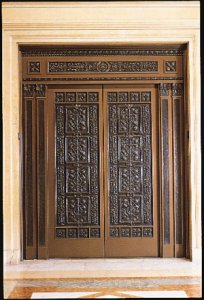
Inside Out: New Perspectives on the
Heinz Architectural Center’s Collection
October 28, 2000 – January 21, 2001
The newly renovated Heinz Architectural
Center opens with a show from the collection that explores how architects
use drawings and models in the process of design, and the way information
is communicated by these forms of representation. Associate curator Tracy
Myers explains, “The show opens with a group of sketches -- really just
thoughts on paper. Then we have elevations, perspectives, sections,
and composite drawings, which work as a hinge for the exhibition.
Then we move from looking at buildings from the outside to looking at them
from their interiors.”
While the center has mounted exhibitions
from the collection before, this is the first that Myers and curator Joseph
Rosa have organized. "Remodeling and expanding the Center gave us a chance
to take a fresh look at our collection. In it we found wonderful
examples of the ways architects have recorded and shared their ideas over
time,” says Rosa.
The new gallery in the Heinz Architectural
Center will be similar to the original galleries, but with several differences
in the details. “There is continuity,” says Myers. “It will
be obvious to the visitor that the new gallery, like the original ones,
was designed by Cicognani Kalla Architects in New York. However,
the new gallery is distinctive in relation to the rest of the Center.
The molding has a flatter profile, the ceiling color is different.
But the design vocabulary is pretty much the same.”
Visions, Fragments, and Impressions:
French Nineteenth-Century Drawings and Bronzes from the Collection of Herbert
and Carol Diamond
September 14 – January 14, 2001
Small bronzes were especially
popular in the 19th century. The Diamond collection contains 23 bronzes
and 60 drawings from a period when great changes were taking place in French
society, changes which are illustrated in the art of the period.
Works by Auguste Rodin, for example, rather than celebrating famous people,
stress the inner thoughts of the model. Jean-Jacques Feuchere’s Satan
embodies another artistic debate as its traditional finish and literary
theme contrast with the unconventional pose of Satan’s body encased in
bat wings.
Aluminum in Contemporary Architecture
November 18, 2000 – February 4, 2001
In an exhibition designed to complement
Aluminum by Design: Jewelry to Jets, associate curator Tracy Myers
of the Heinz Architectural Center has organized an exhibition of architectural
works from the 1990s that make use of aluminum. The projects range
in scale from a small workshop and office in Texas to a 27-story office
tower designed for Bangkok. “What became clear to me as I was reading
through the research for this exhibition,” says Myers, “is that aluminum
has been used in all types of buildings and in many forms, from sheathing
in a corrugated aluminum skin to the fixings that keep plate glass together
in a curtain wall.”
Aluminum is a desirable building material
for many reasons – it is cheap, lightweight, and resists corrosion.
“There is a public elementary school outside Atlanta that is covered in
aluminum that looks like fish scales,” Myers says. “The architects wanted
to give the building a specific architectural identity, but they had a
limited budget. Now the school building stimulates the students’
interest in structures and design.”
The exhibition will consist of works on
paper, photographs, models, and many examples of Computer Aided Design.
“Sometimes the desire to use aluminum necessitates the use of CAD,” Myers
adds. “And sometimes it becomes clear in the design process that the only
material that will work is aluminum.”
Some of the architects included in the
exhibition are Sir Norman Foster, TEN Arquitectos in Mexico City, and Kohn
Pedersen Fox.
|


